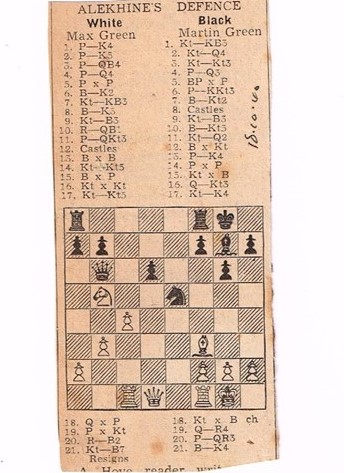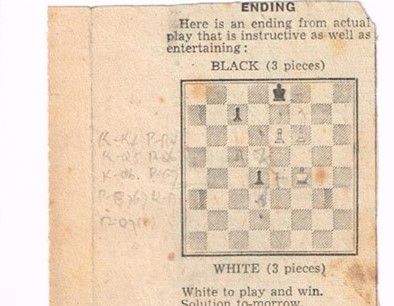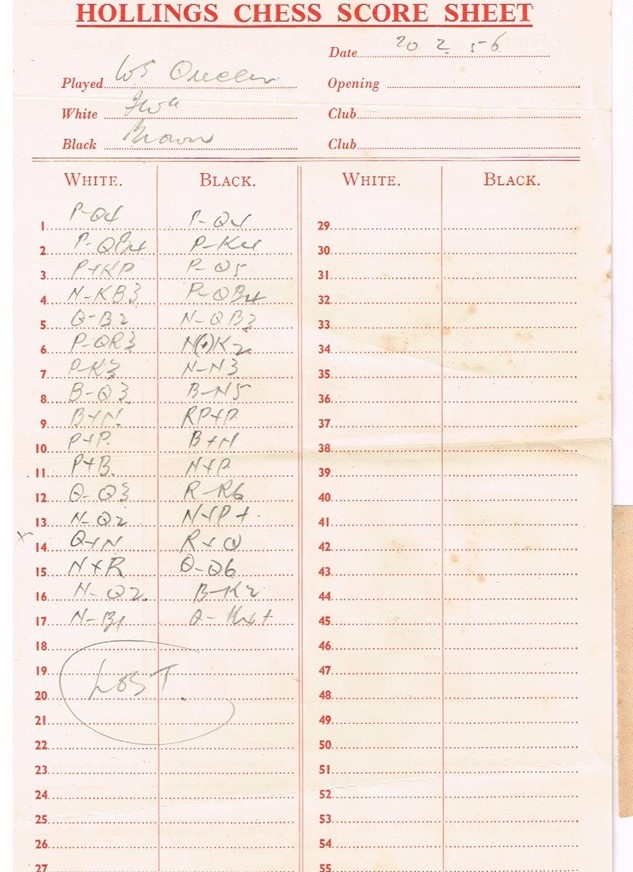Kev Byard is a former member of our chess club who emigrated to New Zealand. He keeps in touch with current club members and participates in our club online tournaments. Kev Byard’s article, also published on the HCA website, relates to an old gem (a 1927 publication of an 1895 title!) that Kev purchased. It wasn’t only the book itself that fascinated him, but what he found within…
An Old Chess Book that I Bought
By Kev Byard
Who was the first person to be a British citizen and to have played in the final of the World Chess Championship? No, it was not our Nigel. However, our question is answered later.
First, though, let’s talk about me. I emigrated to New Zealand in 2004, after which I immediately gave up chess for reasons that are totally to do with the appalling state of chess clubs in Auckland and nothing to do with any waning interest in the game on my part. As a result I gave up the game. So, because I had been living in the chess wilderness for such a long time, the decision of Chandlers Ford Chess Club to move online was therefore a Godsend to me. And, following my first foray into competitive chess for seventeen years via the weekly online CFCC Arena and Swiss tournaments (I’m still shaking after my baptism of fire in my first ever game against Kev Lamb, whose style clashes completely with mine!), my interest has been thoroughly rekindled. [See previous Post about Kev Byard’s first Chandler’s Ford Online Tournament].
Indeed, immediately following my first such tournament on 19 November 2020, where I achieved a very proud third place and a much-treasured bronze cup, I ventured into the cold, dark, damp basement under my house to find my collection of chess books that had lain undisturbed for seventeen years in a large plastic box, in which also lies a signed non-chess autobiography by Brian Clough. I successfully retrieved all but one of my endgame books (the other is titled, ‘Tactical Chess Endings’ – the word ‘Tactical’ put me off!) and nothing else. However, after an online discussion about openings (Philidor’s Defence in particular) with djc202, john_zed, WillHeSac and KevLamb, I decided to have a further rummage and I found a few other books on the openings. It was during the retrieval of my four books on the Philidor Defence and my seven books on the Scandinavian Defence (which I didn’t open) that I stumbled on an absolute gem of a volume that I had long, long neglected. Now, I know most of us are guilty of not having read every book in our collections (my own copy of Staunton’s Chess Player’s Handbook remains virtually unopened) but I really should have made much more of an effort to delve into this particular 1927 publication.
An old Chess Book


Let’s look at my copy of Gunsberg’s book. Bearing in mind that the book is titled ‘The Chess Openings’ its 1927 content is fascinating. Each chapter provides a brief description (typically one page) of an opening, followed by columns of analysis, MCO-fashion. Each opening is afforded a number of such columns. The breakdown of the numbers of columns for each of the openings, and in order of appearance in the book, is as follows:
| Opening | Number of columns |
| French Defence: | 4 columns |
| Sicilian Defence (N.B. 1. e4 c5 2. Nc3 – that’s all, no other 2nd moves for White!) | 4 (only 4 columns– unbelievable when one considers the statistics below) |
| Centre Counter: | 4 |
| Philidor’s Defence: | 8 (yes, 8!) |
| Petroff’s Defence: | 8 |
| Ponziani’s Opening: | 4 |
| Scotch Opening: | 16 (seeing any patterns?) |
| Ruy Lopez: | 12 |
| Two Knights’ | 12 |
| Giuoco Piano: | 8 |
| Evans Gambit Declined (yes, JUST the declined): | 4 |
| Evans Gambit (accepted): | 10 |
| Bishops Opening: | 4 |
| Centre Game: | 4 |
| Danish Gambit/Game: | 4 |
| King’s Gambit Declined: | 8 (how DARE we decline?) |
| King’s Gambit Accepted; King’s Bishop Gambit (3. Bc4): | 8 |
| KGA Cunningham Gambit: | 4 |
| KGA King’s Knight Gambit: (3. Nf3): | 4 |
| KGA Salvio Gambit: | 4 |
| KGA Muzio Gambit: | 4 (!!) |
| KGA Kieseritzky Gambit: | 8 |
| KGA Allgaier Gambit: | 12 (!) |
| Vienna: | 12 |
| Bishop’s Opening: | 4 |
| From’s Gambit (NB NOT Bird’s Opening!): | 3 |
| English Opening: | 8 |
| Reti (called the Zukertort in Gunsberg’s book): | 8 |
| Queen’s Pawn opening (incl. Dutch) | 8 |
| Queen’s Gambit Declined: | 8 |
What’s most interesting, I think, about this list is the complete dominance of lines that include an f4 gambit by White over almost anything else, in particular the King’s Gambit. Indeed, there are 68 columns that include the f4 move (52 being directly the KGA or KGD) out of only 209 columns in total (33% of all columns). Also the entirety of the Queen Pawn openings is dealt with in only 16 columns (8%). The French and Sicilian are relegated to mere sidelines in Gunsberg’s push for a White f4 and these openings are given the same space (5 columns) as the Muzio Gambit on its own, would you believe?
The French Defence, admittedly being the first opening addressed in Gunsberg’s book, is described disparagingly in its first paragraph thus: “It seems almost superfluous to explain that the French Defence is resorted to by players who do not care to face the attack which may result from Black’s reply of P-K4.” I hope, Graham, you are hanging your head in shame! That said, those who wish to play 1.d4 are also not let off the hook by Gunsberg who says,”…[players playing 1.d4] of even mediocre talent are often enabled to make a display of strength against better players than themselves.” Now that IS disparagement!
Intriguing extras
However, while the book itself is an absolute treasure, the real gems were to be found in the extras that were between the pages of the book upon my opening it when I arrived home. Between the leaves of this volume I found two newspaper cuttings and, far more importantly, a recorded game from a previous owner of the book (did I mention that when I bought the book it was second-hand?) who failed to retrieve his (her?) score sheet. Absolute gold!


The first cutting is a game played between a Max Green and a Martin Green, maybe two brothers, and won by Martin as Black. A note scribbled on the cutting it is a date: 18/10/40, more likely the date of the game than the actual date of the cutting, which appears to be from the 50’s or 60’s. The game itself is an Alekhine’s defence, as indicated by the title, which was a win for Black (take note john_zed). According to Stockfish, White’s decisive error was 20.Rc2. Stockfish gives 20.Rfd1 as equal (0.0). After Black’s error of 20.Rc2 a6 Stockfish recommends 21.a4 (-5.0) since 22.Nd4 loses to 22…Rfd8. Pity the players didn’t have access to Stockfish in those days – or is it? Are we really better off these days having access to the correct move at our fingertips without the satisfaction of having to have worked for it? I tried to find out the date of this cutting so I looked at the reverse to find a list of football fixtures from the South Regional and North Regional leagues. This seems to predate the football league but a Google search of the games themselves (e.g. Arsenal v Northampton) didn’t uncover the date of the cutting, which makes me doubt the veracity of Google searches. Therefore there seem to be no clues as to the real date or origin/paper the cutting came from but this adds to its fascination. That said, if there are any football geeks out there, I’d like to see evidence of the date – note that Southampton played away to Watford.
An End-game study

The second cutting is an endgame study, again probably from the same era as the first cutting of the game between the Greens. This is a pawn ending with White to play and win. It’s really complicated so put it into Stockfish and don’t let anyone tell you that pawn endings are easy! The reverse of this is just a few adverts so no clue as to its date, although if anyone has an Austin, a Fiat, a Ford, a Hillman, an MG, a Morris, or a Riley then go to 336 New Cross Road, London S.E.14 and you can get cash for it, otherwise there are no other clues. Again, any information as to the date of this piece would be gratefully received.
Hollings score-sheet

The third extra piece that I found is by far the best and is the stuff of chess dreams. It is a ‘Hollings Chess’ score-sheet from a game played on 20th February 1956 which was a Monday. The reverse of the score-sheet states that Hollings Chess was run by a Frank Hollings, Great Q. Street, Kingsway, London. I’ve never heard of Hollings. Has anyone else? Also, the reverse of the sheet advertises a number of books that can be purchased from Hollings, including ‘How to Play Chess Endings’ by Znosko-Borovsy. I actually have this book and would heartily recommend it, so if you are able to save up 12s 6d, the price listed for this book on the reverse of the score sheet, and send your postal order to 68 Great Queen St., Kingsway, London W.C.2 then you’ll be handsomely rewarded. Alternatively, telephone Holborn 8104. The game on the Hollings score-sheet itself is between a (Mr?) JWG and someone called Brown, which is a win for Brown as Black. After an Albin Counter Gambit, Black gradually builds up a slightly better position (Stockfish says -2.6 after 12… Rh3 but then White blunders with 13.Nd2 after which 13…Nxf3+ wins the white queen for a rook and knight and, soon after that the game, although Stockfish says that 13…Qd7 is just as good.
Yes, I know all these extras in a book, and their analyses, are irrelevant, superfluous and inconsequential, but to find such gems inside an already fascinating volume and be able to use modern technology to study them is highly interesting and great fun.
Has this ever happened when you buy a chess book? It has happened to me on other occasions and I’d be interested to hear of your experiences.
Kev Byard

Date of cutting is 18/10/1940. The football fixtures on reverse were played 19/10/1940.